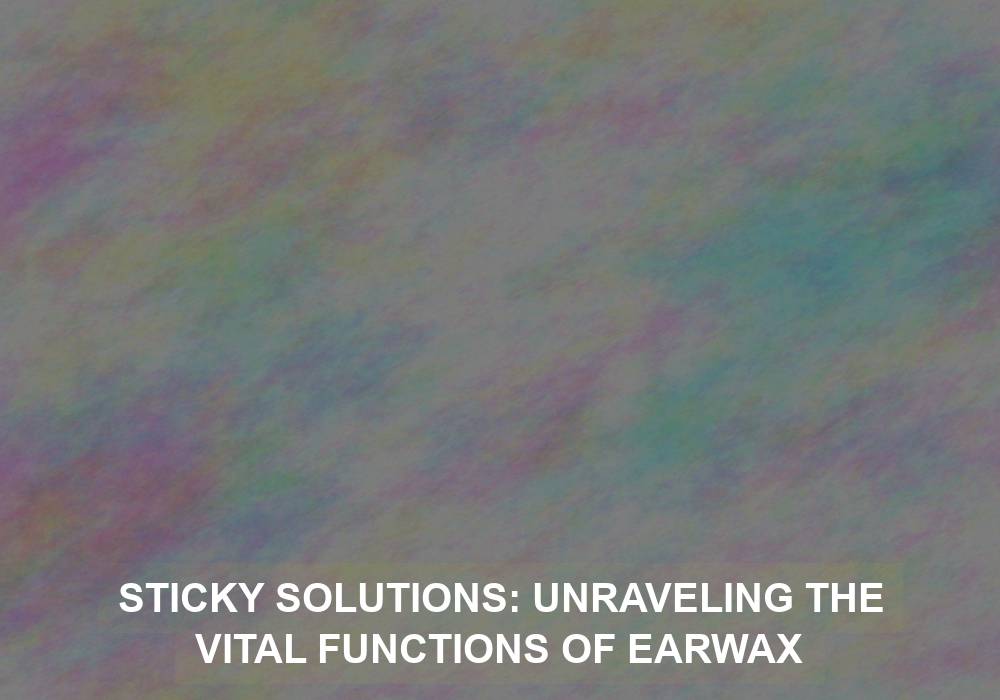Earwax, also known as cerumen, is a sticky substance produced by glands in the ear canal. Although often considered an unwanted nuisance, earwax actually plays a crucial role in maintaining the health and functionality of our ears. In this article, we will delve deeper into the vital functions of earwax and explore its importance in our auditory system.
What is Earwax and How is it Formed?
Earwax is a waxy substance that is naturally produced by the ceruminous glands in the ear canal. These glands are responsible for secreting a mixture of dead skin cells, hair, and lubricating substances, forming earwax. The composition of earwax can vary from person to person, with some individuals producing more than others.
Earwax serves as a protective barrier in the ear canal, preventing dust, debris, and harmful substances from entering the inner ear. It acts as a natural defense system, thanks to its sticky nature, which traps particles and prevents them from reaching the delicate structures within the ear, including the eardrum.
Lubrication and Moisture
In addition to its protective function, earwax also serves as a lubricant, keeping the ear canal moisturized and preventing dryness and itching. The presence of earwax helps to maintain the optimal moisture levels in the ear, which is essential for the health of the ear canal’s skin lining. Without the lubricating properties of earwax, the ear canal may become dry, leading to discomfort and potential damage to the skin lining.
Furthermore, the lubricating properties of earwax facilitate the smooth movement of the jaw. The jaw’s movement is necessary for activities such as chewing and talking. Without proper lubrication, friction can occur between the jaw and the skull, increasing the risk of temporomandibular joint (TMJ) disorders. Therefore, earwax plays a role in minimizing this risk by providing lubrication in the ear canal.
Self-Cleaning Mechanism
Another fascinating function of earwax is its ability to self-clean the ear canal. As new earwax is produced, older wax gradually moves from the inner ear to the ear opening. This movement is aided by natural chewing and jaw movements, as well as the growth of new skin cells in the ear canal.
The self-cleaning mechanism of earwax helps to maintain the cleanliness of the ear and prevent blockages. As the older earwax migrates outward, it carries with it any trapped debris, dust, or small insects that may have entered the ear. This process ensures that the ear remains free from foreign particles, allowing for optimal hearing and reducing the risk of infection.
Earwax and Sound Conduction
Believe it or not, earwax also plays a role in sound conduction. In its normal state, earwax does not interfere with the transmission of sound waves into the ear canal. However, excessive buildup or hardened earwax can impede sound conduction, resulting in reduced hearing or even temporary hearing loss. It is important to note that attempting to clean the ears using cotton swabs or other objects can push the wax deeper into the ear canal, potentially causing blockages and hearing problems.
To ensure proper sound conduction and optimal hearing, it is crucial to maintain a healthy balance of earwax in the ear canal. Regular cleaning of the external part of the ear without inserting any objects into the ear canal is recommended. If excessive earwax buildup becomes a problem, seeking professional assistance from an audiologist or healthcare provider for safe removal is advisable.
The Dangers of Excessive Earwax
While earwax is essential for maintaining ear health, excessive buildup can lead to complications. Individuals who produce excessive earwax or have narrow ear canals may experience earwax impaction. This occurs when the wax becomes tightly packed in the ear canal, causing discomfort, hearing loss, tinnitus (ringing in the ears), and even dizziness. Seeking professional assistance from an audiologist or healthcare provider is important for the safe and effective removal of impacted earwax.
Tips for Earwax Management
To effectively manage earwax and promote optimal ear health, here are some tips:
-
Avoid inserting objects into the ear: Contrary to popular belief, using cotton swabs, bobby pins, or other objects to remove earwax can be harmful. It can push the wax deeper into the ear canal, potentially causing blockages or damage to the sensitive structures.
-
Practice good ear hygiene: Gently clean the external part of the ear using a soft cloth or tissue. Avoid inserting anything into the ear canal.
-
Use earwax softeners: If you frequently experience earwax impaction, your healthcare provider may recommend using earwax softeners or eardrops to help loosen the wax. These should be used as directed by a professional.
-
Seek professional assistance: If you suspect earwax impaction or experience persistent ear discomfort, it is advisable to consult a healthcare provider or audiologist. They can safely remove the excess wax and provide guidance on maintaining ear health.
Conclusion
In conclusion, earwax is not just a sticky substance to be disregarded. It serves essential functions in protecting our ears, lubricating the ear canal, facilitating self-cleaning, aiding sound conduction, and maintaining ear health. While it is important to exercise caution and seek professional help when necessary, understanding the significance of earwax can help us appreciate its role in our auditory well-being. So next time you notice earwax, remember the vital functions it serves and the importance of maintaining a healthy balance.
